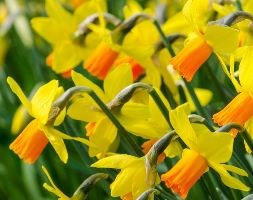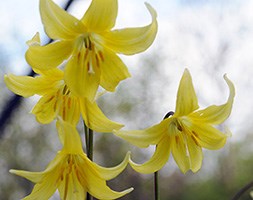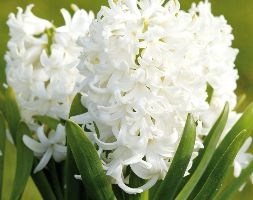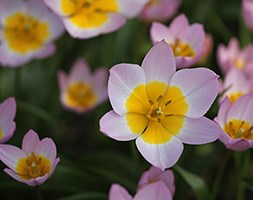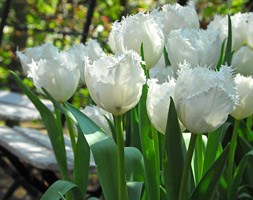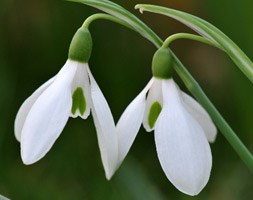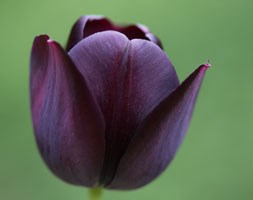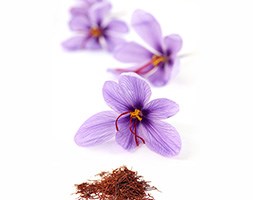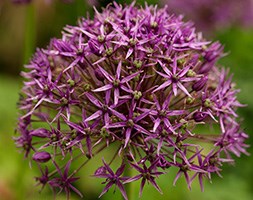Price reductions at Crocus
by Sarah - October 22nd, 2013.Filed under: Crocus, Price Reductions.
Crocus reduced the price on these items today
Narcissus ‘Jetfire’ (cyclamineus daffodil bulbs) was £4.99 now £2.99
Position: full sun or partial shade Soil: well-drained soil (for container-grown bulbs use two parts John Innes No2 compost to one part sharp grit) Rate of growth: average Flowering period: March and April Flower colour: yellow Other features: narrow, strap-like leaves; contact with the sap may cause skin irritation Hardiness: hardy Bulb Size: 10/12 The dramatically swept back golden yellow petals surround a bright orange trumpet, giving this sturdy daffodil a windswept look. They appear in early spring and are ideal for naturalising in bold drifts where they will carpet the ground with their golden flowers. Also suitable for pots if space is limited, so their bright and cheerful colour can be enjoyed close at hand. Garden care: Plant 10-15cm (4-6in) deep from late summer to early autumn. After flowering feed with a balanced fertiliser, dead-head and allow the leaves to die back naturally.
Erythronium ‘Pagoda’ (dog’s tooth violet bulbs) was £3.99 now £2.99
Position: partial to shade Soil: fertile, humus-rich, freely draining soil that does not dry out Rate of growth: fast Flowering period: March and April Flower colour: yellow Hardiness: fully hardy Bulb size: 1 Each stem of this plant will carry up to 10 nodding, sulphur-yellow flowers with a brown central ring and deep yellow anthers. The foliage can be equally showy as it has either bronze-mottled, or fainter white marbling on the deep green, glossy leaves. In early spring this combination makes a very colourful display in woodlands and meadows. This is a vigorous plant which will form clumps and spread. Garden care: Plant bulbs 15 – 20cm deep and 15cm apart in naturalistic drifts where they can be left undisturbed for several years. Try to avoid planting under shrubs or trees that will soak up all the soil moisture in the summer.
Hyacinthus orientalis ‘White Pearl’ (‘prepared’ hyacinth bulbs) was £3.99 now £2.99
Position: full sun or partial shade Soil: any well-drained, moderately fertile soil (for container-grown bulbs use two parts John Innes No2 compost to one part sharp grit or bulb fibre) Rate of growth: average to fast Flowering period: January to March Flower colour: white Other features: all parts of the plant may cause a mild stomach upset if ingested; contact with the bulbs may cause skin irritation Hardiness: fully hardy Bulb size: 16/17 Tightly-packed columns of white, bell-shaped flowers look magnificent in winter or early spring and will fill your home with their delicious scent. They make an elegant table centre for special occasions, and can be used as a longer-lived alternative to a traditional cut bouquet. ‘Prepared’ hyacinths have been through a sequence of cold treatments, which triggers the growing process. This means they tend to flower much earlier than ‘unprepared’ hyacinths, and they are mainly grown as indoor plants, where their strongly scented flowers will fill your room with their sweet perfume. ‘Aiolos’ produces densely packed, cylindrical clusters of highly scented, ivory white flowers, which may be in flower as early as Christmas. Garden care: Using gloves plant bulbs close together (but not touching), into shallow bowls containing bulb fibre, so their tops are just above the surface of the compost. After potting up, they will need a cool, dark period, which will encourage root growth, so pop them into a black bin liner and leave in the shed or garage. Check them occasionally to make sure the compost does not get too dry, and water them when necessary. When the growing shoot is about 5cm tall, take it out of the bag and bring the pot inside to a cool room away from direct sunlight until the leaves turn green. Afterwards they can be moved closer to the window, but if possible keep them away from central heating radiators. After they have finished flowering they can be planted outside in the garden, where they will flower again (in March or April) the following year. These bulbs can also be grown in specialist bulb vases. Simply fill the vase with water up to its neck and then sit the bulb on top, making sure the base of the bulb is just above the water. Then treat it in the same way as the potted bulbs.
Tulipa saxatilis (Bakeri Group) ‘Lilac Wonder’ ((Bakeri Group) tulip Lilac Wonder bulbs) was £3.99 now £2.99
Position: full sun Soil: fertile, well-drained soil Rate of growth: average Flowering period: April-May Flower colour: pinkish-lilac Other features: all parts of the plant may cause a mild stomach upset if ingested; contact with any parts of the plant may aggravate skin allergies Hardiness: fully hardy Bulb size: 5/7 Bowl-shaped mauve-pink flowers, with a paler interior and a luminous, well-defined eye, appear in profusion from mid-spring. Compact in habit, they are ideally suited to pots or windowboxes, as well as filling gaps towards the front of the border. Garden care: In November or December plant bulbs 10-15cm deep in fertile, well-drained soil. After flowering dead-head and apply a balanced liquid fertiliser each week for the first month.
Tulipa ‘Swan Wings’ (fringed tulip bulbs) was £3.99 now £2.99
Position: full sun Soil: fertile, well-drained soil Rate of growth: average Flowering period: May Flower colour: white Other features: excellent cut-flowers Hardiness: fully hardy Bulb size: 11/12 Fringed tulips not only give you spring colour, but the dissected petal edges also create textural interest. These flowers are glowing white, so are perfect for creating a classy look in borders and pots. Garden care: In September to December plant bulbs 15-20cm deep and 10-15cm apart in fertile, well-drained soil. Alternatively, allow 7-9 bulbs per 30cm sq. After flowering dead-head and apply a balanced liquid fertiliser each week for the first month. Once the foliage has died down naturally lift the bulbs and store in a cool greenhouse.
Galanthus nivalis (common snowdrop bulbs) was £3.49 now £2.99
Position:sun or partial shade Soil: humus-rich, moist but well drained soil Rate of growth: average Flowering period: January and February Flower colour: white Other features: all parts of the plant may cause a mild stomach upset if ingested; contact with the bulbs may cause skin irritation Hardiness: fully hardy Bulb size: 4/5 It’s hard not to love these wonderful bulbs for adding colour to the garden when little else is awake. The nodding white flowers have a small green marking on the inside of each tepal, are honey scented, and appear in late winter. They look particularly good planted in large drifts in grass where they will naturalise quite happily. Alternatively plant them up in clumps in the front of mixed borders, or into pots so they can be admired close up. Garden care: Plant bulbs 5cm deep in dense clusters to form naturalistic drifts. Where bulbs are planted in grass do not cut the grass until after the leaves have died right back. Divide large colonies after flowering while the leaves are still green for use in other moist, well-drained areas.
Tulipa ‘Queen of Night’ (single late tulip bulbs) was £3.99 now £3.49
Position: full sun Soil: fertile, well-drained soil Rate of growth: average Flowering period: Apr-May Flower colour: purple-black Other features: excellent cut-flowers Hardiness: fully hardy Bulb size: 12/+ These are probably the best loved of the deep purple tulips. Their velvety, dark maroon, single, cup-shaped flowers on straight stems in May are stunning, so they do deserve their acclaim. The almost-black tulips work well in a ‘bruised’ coloured border, planted between other plum-coloured flowers and foliage plants. Shown here photographed with tulip ‘Shirley’ Garden care: In September to December plant bulbs 15-20cm deep and 10-15cm apart in fertile, well-drained soil. Alternatively, allow 7-9 bulbs per 30cm sq. After flowering dead-head and apply a balanced liquid fertiliser each week for the first month. Once the foliage has died down naturally lift the bulbs and store in a cool greenhouse.
Crocus sativus (saffron crocus bulbs) was £3.99 now £3.49
Position: full sun Soil: gritty, poor to moderately fertile, well-drained soil Rate of growth: average Flowering period: October and November Other features: slender, strap-shaped, mid-green leaves Hardiness: fully hardy Bulb size: 6/7 Grow your own saffron (the most expensive spice in the world), with this beautiful crocus. It produces large, rich lilac flowers with distinctive purple veins in October and November. An autumn-flowering crocus, it is named after its three long, deep-red stigmas, which are cultivated commercially for colouring and flavouring food. To provide the conditions in which it needs to thrive plant the bulbs in August or September in gritty, well-drained soil. Garden care: Plant bulbs in naturalistic drifts 10-15cm (4-6in) deep in August in gritty, well-drained soil. Where bulbs are planted in grass do not cut the lawn until after the leaves have died back.
Allium stipitatum ‘Violet Beauty’ (allium bulbs) was £3.99 now £3.49
Position: full sun Soil: fertile, well-drained soil Rate of growth: average Flowering period: June Hardiness: fully hardy Bulb size:10/12 Elegant, slender stems are topped with somewhat flat-bottomed, dome-shaped clusters of violet flowers, which mix easily with most shades of blue and purple. Garden care: Plant bulbs 15cm deep and 15cm apart to enjoy the full effect of the flowers. Avoid excessive soil moisture, and split and divide large clumps in autumn or spring.







